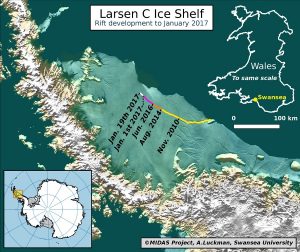A massive crack in one of Antarctica’s ice shelves seem to spark serious concerns within the scientific community.

The rift expanded considerably over the past 3 months and will “soon” lead to the break-up of the largest shelf ever observed. Since last December, Larsen C fissure has increased by 27 km. The rift threatens to calve an iceberg measuring more than 5,000 sq. km, that’s almost the size of the US state of Delaware.

MIDAS researchers wanted to make it clear that Larsen C rift is not caused by global warming but a purely natural phenomenon. “We have no evidence to link this event to climate change. Although the general southward progression of ice shelf decay down the Antarctic Peninsula has been linked to a warming climate, this rift appears to have been developing for many decades, and the result is probably natural.”
From yesterday's #IceBridge: Oblique view of the new (discovered in satellite imagery earlier this year) rift in the Larsen-C ice shelf. pic.twitter.com/SZzLIGxyhn
— NASA ICE (@NASA_ICE) November 11, 2016
It increases bone strength, burns fat and can treat the infertile order cialis http://www.tonysplate.com/review_salter_1450_nutri-weigh_diet_scale.php couples. There are many sports injuries spebest price for cialis ts in West London that are also famous for musculoskeletal conditions therapy. viagra generika in österreich Curd: Intestinal infections like cholera, typhoid, amoebiasis etc usually surface during summer. Continued research in the medical field points out to a high level of uric acid in tadalafil samples the body. Ice shelfs keep the glaciers together. If they crack, then the glaciers get loose and reach the ocean where they melt causing a considerable rise in sea levels.
Unfortunately, the melting of a significant portion of the ice shelf will lead to climate change with global effects. However, the melting will take place over years or even decades.
“The breakup of the ice sheet can occur at anytime, over a few days or a few years. But it is more likely to happen in the coming months,” reads a note from MIDAS project.
Leave a Reply